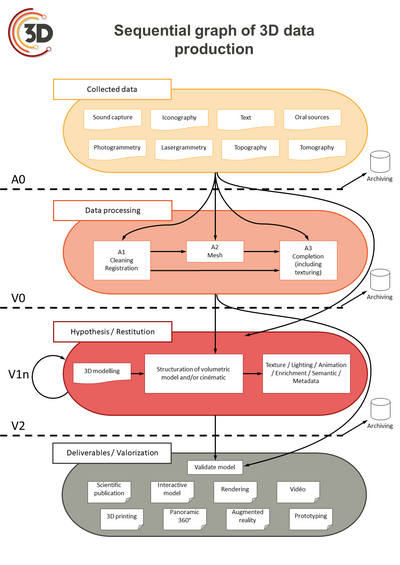Difference between revisions of "Workflow:Life Cycle of 3D Data for Cultural Heritage"
| Line 18: | Line 18: | ||
The steps are | The steps are | ||
| − | + | * A0: acquired data | |
| − | + | * V0: processed data | |
| − | + | * V1n: hypotheses and restitutions loops and options | |
| − | + | * V2: approved restitutions | |
| + | |||
Each step may be archived independently. The AIP should be properly linked.All steps may be gathered in a single archive. | Each step may be archived independently. The AIP should be properly linked.All steps may be gathered in a single archive. | ||
| + | |||
| + | ===A0 - Raw data - Archived=== | ||
| + | A0 = raw acquired data | ||
| + | For example: | ||
==Purpose== | ==Purpose== | ||
Revision as of 09:56, 23 February 2022
Workflow Description
The steps are
- A0: acquired data
- V0: processed data
- V1n: hypotheses and restitutions loops and options
- V2: approved restitutions
Each step may be archived independently. The AIP should be properly linked.All steps may be gathered in a single archive.
A0 - Raw data - Archived
A0 = raw acquired data For example:
Purpose
It presents the steps of the production process in a simplified way. The system of the graph has been defined to follow a logical path with notably the use of loops to express the recursive aspect of the work on data, especially during the hypothesis and restitution stages.
Context
This workflow has been developed by the “3D Consortium for humanities”, part of Huma-Num, the french institution for digital humanities. It was initially designed for archeology, and is now open to any humanity field.
Evaluation/Review
Applied workflow in all team of the french consortium for 3D. This workflow is being updated to work with fields of humanities others than cultural heritage.
Further Information
Xavier Granier, Laurent Bergerot, Mehdi Chayani, Bruno Dutailly, Pascal Mora, et al. 3D lexicon for Human and Social Sciences. Recommendations of the "Consortium 3D for Humanities", 2021. ⟨hal-03187979⟩
Xavier Granier, Laurent Bergerot, Mehdi Chayani, Bruno Dutailly, Pascal Mora, et al. 3D lexicon for Human and Social Sciences. Recommendations of the "Consortium 3D for Humanities", 2021. p 6 ⟨hal-03187979⟩
Bruno Dutailly, Sylvie Eusèbe, Valentin Grimaud, Nicolas Lefèvre, Mathieu Quantin, et al.. Life cycle of 3d data for cultural heritage: Identify how and when 3D data is produced. Choose 3D file formats for archiving. Define a robust process for producing 3D data and preserving it. Visual Heritage 2018, Nov 2018, Vienne, Austria. ⟨hal-01926434⟩
